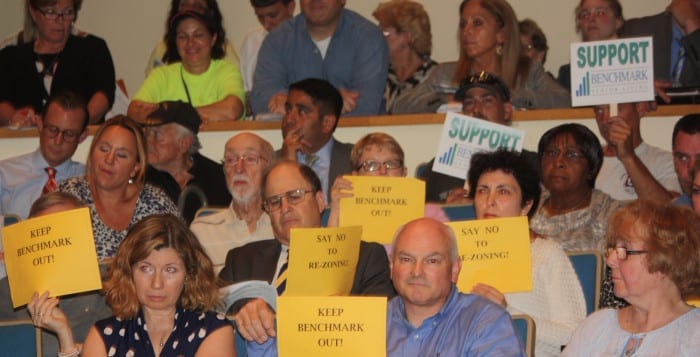Plans to build a 69-unit assisted living facility in a residential, wooded Huntington neighborhood were largely met with heavy censure by neighboring residents at a town board public hearing on Tuesday night.
The room was filled to the max with individuals holding up signs for and against the proposal, and jeering and applause often punctuated speakers’ statements. Out of the nearly 35 individuals who spoke, most residents opposed Massachusetts-based Benchmark Senior Living’s plans to build the facility at the corner of East Main Street and Washington Drive, calling the proposal too dense for the area and criticizing the traffic, noise and sewage treatment aspects of the project. The residents called on the town board to reject the company’s proposal to rezone the six-acre land, which has both C-3 Special Business and R-10 Residential zoning, to R-HS Residential Health Services District, a designation that would make way for the facility.
The project has gone through several versions. The proposed number of units has been brought down from 87 to 69 units, and the proposed on-site sewage treatment plant has been moved to the northwest corner of the lot, adjacent to commercial property. A 40-foot-wide natural buffer along Old Northport Road will be built, and the gross floor area would be slightly reduced from 70,567 square feet to 66,995.
Representatives for the developer said at the meeting that the project would meet the needs of a growing senior population in Suffolk County and especially in Huntington Town. But many residents expressed frustration over the zone change request, urging the board to keep the zoning of the current land intact.

“Shoehorning a large-scale facility into this spot that would house 100 to 150 people including the staff is so far from the original zoning plan that it renders zoning laws absurd,” Jane Carter, a Cobb Court resident said. “Why do we have zoning laws in the first place? They’re there to protect us.”
Meanwhile, the plan got some support by fewer than a handful of residents, including the construction industry. The developer’s team of representatives argued the proposal is a good use for the site and for the town. John Dragat, senior vice president of development at Benchmark, said the plan destroys fewer trees than previous plans for the site, which included eight homes and an office building. Benchmark’s proposal covers less of the lot and, square-footage wise, isn’t much greater than the plan for the homes, Dragat added.
“In fact, we believe it’s a very responsible proposal,” he said. “It’s respectful of the surrounding community.”
Still, residents were not sold. Astrid Ludwicki, an Old Northport Road resident, said the project was too dense and called it a “monstrosity.”
“This building is too large,” she said. “It’s for Benchmark’s profits, clear and simple.”
Petitions opposing the project have been submitted to the town. Town Clerk Jo-Ann Raia (R) said if they’re valid, it could mean the board would need a supermajority vote — four out of five — to approve the zone change, versus a simple majority of three.
After the meeting, Supervisor Frank Petrone (D) said in an interview that the town’s planning staff would review the proposal. Asked for his sense of how the community feels about the project, he said “they’re against it.” The supervisor also said he agreed with the applicant’s claim that this type of facility is needed.
“I think there is a need,” he said. “I think everybody will say there’s a need. Now depending on if it’s in the right spot, we have to analyze that.”















